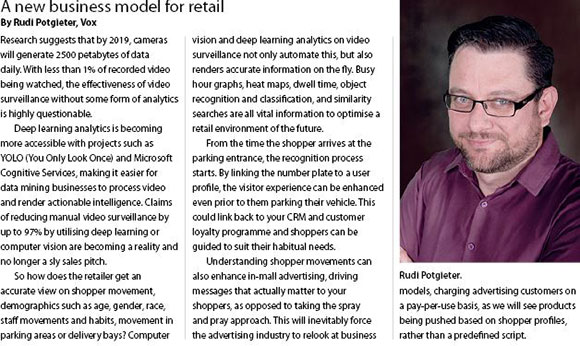

The retail industry finds itself in the middle of a dramatic change. Apart from economic pressures and increased competition, the industry is also facing competition from other areas, such as online retailers.
While economics will ensure that certain types of stores are unlikely to vanish completely in Africa and South Africa, others face significant pressures and have tried to counter the various threats by launching their own online stores or partnering with Internet based retailers for delivery and so forth. But challenges still remain.
When it comes to brick-and-mortar stores, the disruption of their business models has only just begun. Today they face the challenges of getting feet through the door and then converting those feet to sales. Often a potential customer will come in, find what they like, then leave and buy it for less online.
The Global Retail Trends 2018 report by KPMG acknowledges that the world of retail has been disrupted and that the challenges are great, however, the report starts by pointing out that the “tools, strategies and technologies required to be successful in this new world are available. The toolbox for success is here, and it’s up to retailers to choose the right tools from the toolbox in order to grow their business.”
Of the five trends highlighted in the report (which can be found at https://assets.kpmg/content/dam/kpmg/xx/pdf/2018/03/global-retail-trends-2018.pdf, or use a short link: www.securitysa.com/*kpmg1), the first is that the customer experience is more important than ever. This is leading to a new metric retailers will be using in future (and some do already), ‘experience per square foot’ as one’s shopping experience will have a far greater impact on your buying decisions than ever before – because in most cases we are spoiled for choice.
The report also quotes the Customers 2020 study by Walker, a customer intelligence consulting firm, which notes: “Customer experience will overtake price and product as the key brand differentiator by the year 2020.”
Two of the other four trends noted in the report that are pertinent to this article include the growing importance of artificial intelligence, and the continued ‘rise of the conscious customer’ – consumers buying based on the ethical conduct of the retailer.
How security can contribute
In the past, none of the above would be of any concern to the security industry, however, things have changed. Today, it’s not only safety and anti-theft issues that security technology can and is expected to serve, but operational issues as well. This, perhaps, is the ideal place to see artificial intelligence the industry is so intently focused on, rolled out with great effect. We should also expect to see security technology used to significantly improve the customer experience.
Hi-Tech Security Solutions asked a few people in the security industry, those specifically dealing with retail, how we could expect to see the retail industry embracing security solutions to advance their businesses.

A typical security solution for retail would see cameras deployed in high risk areas, or for a general overview, connected to a VMS platform that will allow security personnel or management to review any security breaches or incidents, according to Vanessa Tyne, senior KAM and team lead at Axis Communications SA.
However, she notes that these solutions can be adapted by deploying analytics onto cameras for different use-case scenarios. “A few examples would be people counting, heat mapping and POS integration. The deployment of analytics now takes the security application and makes it a solution that can guide the business as to how their operations are actually performing.”
She adds that people counting is probably the largest solution being used right now. By using an overview camera at the entrance of a retail shop, for example, and adding in people counting analytics will allow the business owners to review how many people are coming in and out of their stores, at what time, and this will allow them to schedule staff better, potentially drop the cost of labour and ensure the level of customer service is being addressed with staff visible and present.
Additionally POS analytics could be added to cameras over till points to ensure all transactions are true and that there is no theft (such as sweet-hearting) at the pay point.
“There are malls in South Africa currently testing this solution in order for them to then charge higher or lower rentals according to customer movement throughout the mall,” Tyne adds. “Additionally, there is a boutique make up retail store currently deploying heat mapping and people counting for the business owner to fully optimise his staff complement.”
A phased approach
One of the benefits of using video surveillance as an operational enhancer is that the rollout is not an all-or-nothing approach. It can be done in phases, even one camera at a time for really cost conscious retailers or those nervous about new technology.
Tyne says a phased approach is manageable depending on the solution currently in store. “One may have to move some cameras around in order for them to perform according to requirement. Another consideration to take in is the resolution of the camera. If using a demographic or facial recognition application, you need a higher resolution camera.”
This type of solution will, however, require more than just the security personnel involved. Tyne suggests operations, marketing and finance managers would need to be involved in the solution design from the start.
“In many instances the security budget is very restricted. However, by showing the finance team a potential reduction in labour costs, for example, we suddenly start seeing a buy-in to the total solution and not just a camera for overview purposes. Using demographic analytics to identify age and gender would enable the store to target its in-store marketing accordingly.”
Tyne adds that there are a number of companies in the market with retail solutions that provide additional operational services. “Axis Communications offers a full suite of retail analytics to enhance business processes. These analytics are edge based, meaning they run on the camera so there is no additional server costs involved, and dashboards with reports and statistics are accessible from the cloud.”
A software solution
ISDS is a South African distributor of surveillance solutions, one of which is BriefCam (BriefCam was recently bought by Canon). While BriefCam is known for its video synopsis functionality in which hours of video can be condensed into minutes, with additional capabilities to search for specific people or items (a person wearing red or a red car, for example), it is also a product of growing interest for the retail market.
ISDS MD, David Heenan, explains that heat mapping and tracking the routes people take through a store, as well as facial recognition provide useful insights to the retail environment which allow management to make better decisions and provide improved insight into what works or doesn’t in the stores. These facilities are built into BriefCam and often are the deciding factor in a purchase decision in the retail market.
The benefit of BriefCam is that it is software-based and can work with a wide variety of cameras – although the system will obviously require adequate resolution to do the more intricate analysis such as facial recognition. (Read more about BriefCam at www.securitysa.com/60383n.)
Tagging for growth

Looking beyond the surveillance market, there are additional technologies being used for security and operational efficiencies. Ilze van Eck, retail GM for Sensormatic at Fidelity ADT Commercial, explains that the Sensormatic brand, known for its lost prevention acousto magnetic products, has expanded its solution offering extensively to add more business benefits.
The company still supplies tags, pedestals and point of sale devices, but it has expanded the capabilities of its products significantly in its Synergy brand. From a security perspective, the tags operate on RFID and acousto magnetic technology to make it harder to shield stolen items as they pass through readers at store entrances and exits (the traditional EAS role). The reader can even detect if someone enters carrying a foil-lined bag (which is used to shield stolen goods from the scanners) and alert security personnel to keep an eye on that person.
But the capabilities of these systems have been extended to provide a constant flow of information (using small amounts of bandwidth) to a centralised dashboard. The management software, called TrueVUE, can collate and analyse this information for one store, or it can be centralised to manage multiple stores over a country or even globally. Now, shrink management ‘as-a-service’ is made possible through converting big data into sensible reports which manage store performance and shrinkage.
One of the additions to the Synergy readers is people counting. The systems will accurately count how many people enter and leave a store, providing more insight into exactly how many of the people coming into a store end up purchasing something. The same systems can also provide insight into theft – are goods being stolen out of the front door or out of the staff entrance? Traffic insight is valuable to retailers not only for conversion rates, but also to indicate if organised retail crime syndicates are active.
The tags themselves incorporate more electronics that can assist in inventory control (as well as security). Instead of scanning a barcode and then removing the tag at the pay point, staff will simply remove the tag and the inventory number will be automatically sent to the POS system. This simplifies the checkout process and avoids sweet-hearting as there is no way to scan the ‘wrong’ barcode so your friends get an expensive item for less.
One global retailer uses this to gain insight into its stores daily, on a global basis. Not only will the inventory in each store be updated in real time, but each morning the staff are told what goods should be taken from stock and put on display – this ensures the store has the right goods in the right sizes available every day. The handheld scanners provided by Sensormatic are even able to guide staff to the right item in the stock holding area.
Hanging a tagged item up in a fitting room could also assist in inventory control. If there is a reader near the hanger, the store could learn that a certain item of clothing looks good to customers and it was tried on numerous times, but rarely bought. This could indicate a design problem, for example. Van Eck adds that new RFID deployments enable 360-degree fitting room solutions that offer more benefits than previous shrinkage and inventory systems.
Sensormatic’s new tags have also been redesigned to remove the separate pin that holds the two sides together (and which can be removed if you know how), which also makes it much more difficult to remove the tag surreptitiously.
A big decision
As opposed to the surveillance approach above, moving to a fully integrated RFID solution as described is a big decision because the full solution requires a change in the way staff and management operate. While it is a big project and commitment, Van Eck says that making the move to a system like Sensormatic improves retail sales by 7% to 9%. In the current retail environment, that is a significant improvement.
“RFID is a journey you can’t back away from,” adds Van Eck, “because it makes such a difference to sales and operations, whether it’s on a per store basis or for a national (or global) retail brand you simply can’t imagine going back to the old way of running your store. Sensormatic solutions bring together loss prevention, traffic insights and inventory intelligence in one single platform with connected devices and hardware, becoming the enabler for retail performance and customer experience.”
All about the customer
In summing up we state the obvious: retail success is all about the customer. As obvious as that may be, however, there are still those that haven’t grasped this concept and driven it throughout their organisations. Even the security market, which traditionally was aimed at catching the bad guys, has to adapt to this reality in the technology and services it provides.
As noted in the KPMG report mentioned above, “Customer experience is the key to success. The commercial battleground is no longer just price, product or efficient supply chain. It is now customer experience.” And, in a world where integration is key, security solutions need to play a role in this regard as well. If you’re not keeping your customers safe and secure, while also making it easier for them to enhance or grow their businesses, there are many companies out there with a killer deal that may see you left in the dust.

For more information contact:
• Axis Communications, +27 11 548 6780, [email protected], www.axis.com
• Fidelity ADT, +27 11 697 7888, [email protected], www.fidelitysecurity.co.za
• ISDS, +27 11 326 4571, [email protected], www.isds.co.za
| Tel: | +27 11 548 6780 |
| Fax: | +27 11 548 6799 |
| Email: | [email protected] |
| www: | www.axis.com |
| Articles: | More information and articles about Axis Communications SA |
© Technews Publishing (Pty) Ltd. | All Rights Reserved.